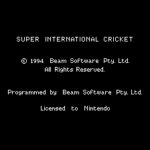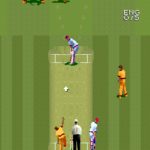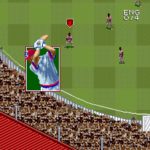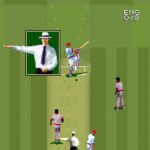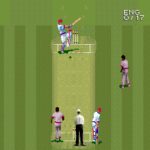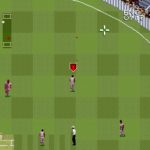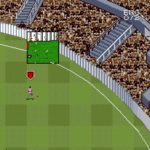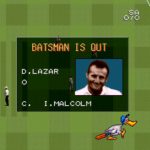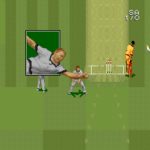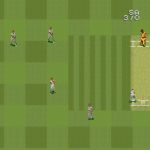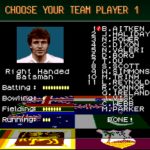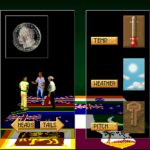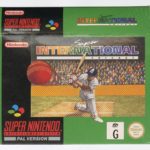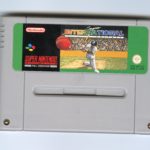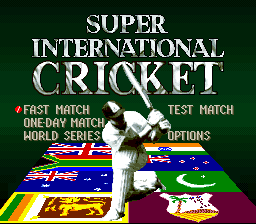
“It recreates cricket almost perfectly , whether that is good or bad depends if you like cricket or not. It’s an excellent sports sim but lacks any arcade style fun.”
“Super International Cricket Review”., Total! Magazine , Issue 43, July 95, pages 34-35
This summary by UK games magazine Total! provides a sense of the challenge of making a cricket videogame. The review was penned by self confessed cricket fan Rob, who found much to admire in Beams sports simulation. Awarding the game an impressive high score of 84%. It was not an opinion share by all at Total! magazine. And in the style of UK games magazine “blokes you can trust” review model, popularised by ZZAP64!! Rob’s colleague Andy also appear on the review pages in little speech bubble offering an opposing opinion. Andy rudely dismisses Super International Cricket stating “This might be just like the real thing but frankly I hate the real thing”. Ensuring that no gamer looking for arcade sports fun looks for it in a cricket sim no matter how well it scores.
A fan of both watching and playing the sport of cricket Total! reviewer Rob reflected that Beam’s game sat closer to act of watching the real game on TV than playing in your backyard but admired how well it captured the thoughtful and tactical nature of the game.
The game contains eight teams (Sri Lanka, Australia, England, South Africa, New Zealand, India, Pakistan and the West Indies). There was no licencing so no actual cricketers are represented but many Beam Staff of the era are listed in the player line up.
The game modes include Fast Match, Test Match, One Day Match and World Series. If offers three layers of gameplay easy, normal and hard. The gameplay resembles that of International Cricket supporting batting bowling and fielding. To bowl players choice the side of the batsman’s and can select the length of the bowl. As befits the nature of cricket speed and spin of the ball is determined by the bowler statistics. Choice of bowls include leg-cutter, out-swinger, in-swinger and off-cutter and the player can control speed of the ball. Batting is simple but allows or selection of batting moves from blocking to sweeping. This is rather contrainted by the Nintento SNES controller but L is a lofted shot. R is a power shot. The player is allowed to move the batter way down the pitch. Running between wickets is very important, as is picking a good running speed on your batsman.
The game has some charming design features. A giant hand lets you move your fielders about. Little animations pop up on the screen punctuating the action with rewards and taunts for the player
Despite it being an international release the scoring is set in the Australian manner, the design brought across from International Cricket designed for an Australian audience.
Many players recall the use of the appeal button as favourite feature of the game. As noted by these reflections on the Reddit cricket forum “r.CRICKET”:
“Always played as West Indies. Move the batsman to the offside and power clip down leg for six as often as I could. And the joy of spamming the appeal button never got old.” (howmanychickens,2013)
“Howzat! Howzat Howzat owzat! I love how play wouldn’t resume until you stop appealing, you could do it forever” (Drop1TwistAndLearn, 2013)
References
Rob., “Super International Cricket Review”., Total! Magazine , Issue 43, July 1995, pages 34-35
” Did anyone else ever play Super International Cricket on SNES?” r.Cricket Forum, Reddit (2005), https://www.reddit.com/r/Cricket/comments/3obiap/did_anyone_else_ever_play_super_international/
Version Information
Super International Cricket was the sequel to the 1992 NES title International Cricket. The earlier International Cricket was released only in Australia by Lazer Beam, Beams publishing arm. Super International Cricket was published by Nintendo Europe receiving distribution in cricketing nations covered by the Nintendo regions.But not into India, one of the greatest cricketing nations as Nintendo, did not have a real presence in India till the launch of the Switch. (See Alwani 2015 and Ghoshal 2017)
References
Ghoshla, Abhimanyu., ” Why has Nintendo ignore India for 30 years?”, TNW, December 30, 2017
Alwani, Rishi., “Tracing the Origins of Gaming in India: 8-bit Cricket, Sega, and Cloning”
https://gadgets360.com/games/features/tracing-the-origins-of-gaming-in-india-8-bit-cricket-sega-and-cloning-640129
Game Meta
Other Names
Additional Creators
Graphics - Dareen Hanna, Alex Efstatiades, Eve Marks, Justin Muir, Grant Arthur
Sound Programmer - Andrew Bailey
Quality Assurance - Steve Scott, Cameron Brown, Gary Ireland, Aaron Smith, Will Bailleu, Simon Tambourine, Peter Shells, Mike Pelman
Conversions
Value Chain
Screenshots
- Start Screen
- Published Nintendo Europe
- Beam Software Logo
- Title Screen
- Menu
- Select Teams
- Bowling
- Pop Up Animation
- Pop Up Animation
- Batting
- Fielding
- Appealing
- Batsman is Out !
- Pop Up Animation
- New batsman
- Fielding
Box Art
- Box Art Front
- Cartridge Front
- Cartridge Rear
Media
Manuals & Walkthroughs
Video

